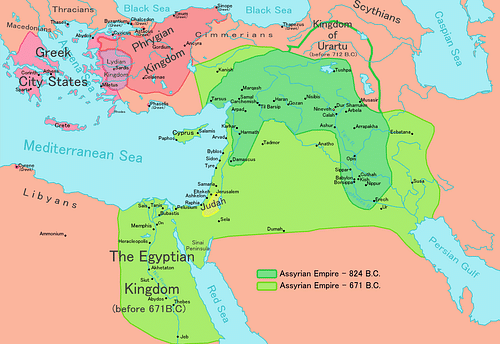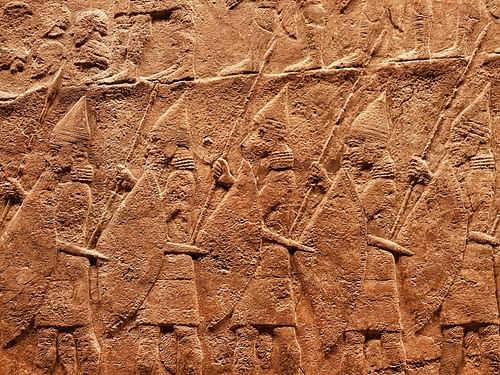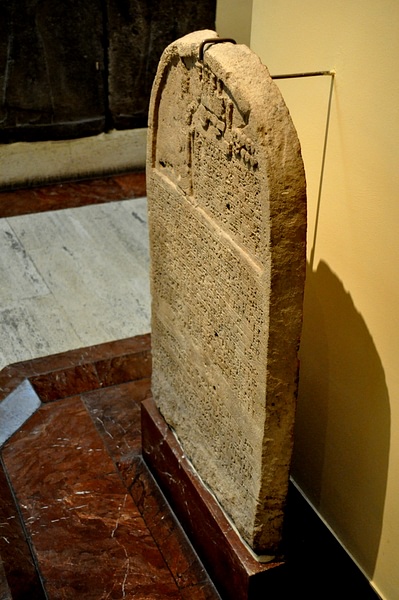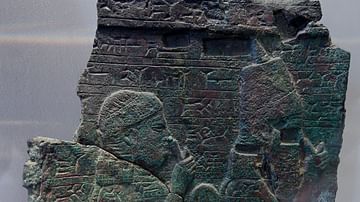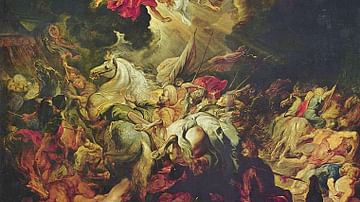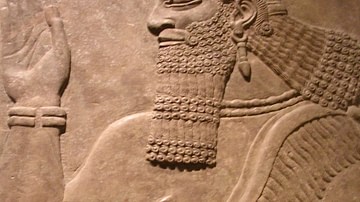
Sennacherib (r. 705-681 BCE) was the second king of the Sargonid Dynasty of Assyria (founded by his father Sargon II, r. 722-705 BCE). He is one of the most famous Assyrian kings owing to the part he plays in narratives in the biblical Old Testament (II Kings, II Chronicles, and Isaiah).
In the modern age, his fame also rests on the poem The Destruction of Sennacherib (1815) by the English poet Lord Byron, a retelling of the Assyrian Siege of Jerusalem of 701 BCE as related in the Bible. He is also known as the second Assyrian king to have sacked Babylon's temples and been assassinated for his affront to the gods (the first king being Tukulti-Ninurta I c. 1225 BCE). It is also possible that he was responsible for the famous Hanging Gardens of antiquity.
Sennacherib abandoned his father's new city of Dur-Sharrukin and moved the capital to Nineveh, which he handsomely restored and ornamented with parks and luxurious gardens. The Hanging Gardens, which traditionally have been attributed to Babylon, and were among the Seven Wonders of the Ancient World, are now thought by some scholars to have actually been Sennacherib's creation at Nineveh. His reign was marked largely by his campaigns against Babylon and the revolts against Assyrian rule led by a tribal chief named Merodach-Baladan. After sacking Babylon, he was assassinated by his sons and was succeeded by his youngest son, Esarhaddon (r. 681-669 BCE).
Early Reign & First Sack of Babylon
During the reign of Sargon II, Sennacherib had effectively maintained the administration of the empire while his father was away on military campaigns. According to inscriptions and letters from the time, Sargon II trusted his son to handle the daily affairs of the state but did not seem to think highly of him as a man or future king. Scholar Susan Wise Bauer writes:
Sargon had, apparently, not been reticent in spreading his opinion of his son abroad. When Sennacherib came to the throne, the provinces – convinced that the crown prince was boneless and inadequate – celebrated their coming freedom from Assyrian rule. (382)
Sennacherib seems to have regarded his father with similar disdain; there is no mention of Sargon II in any of Sennacherib's inscriptions and no record of any monuments or temples linking Sennacherib's reign and accomplishments with his father's. Sargon II's new capital city of Dur-Sharrukin, which Sennacherib had been forced to oversee the construction of for ten years, was abandoned shortly after Sargon II's death and the capital moved to Nineveh.
Since Sennacherib had been forced to play the role of government official under his father, it is understandable that the people, at his ascension to the throne, might have considered him weak; unlike other Assyrian kings of the past, he had never accompanied his father on campaign and so had never proved himself in battle.
One of these campaigns, among the last Sargon II ever led, was against a tribal chief named Merodach-Baladan who had taken the crown of Babylon and control of the southern region of Mesopotamia. Sargon II had defeated Merodach-Baladan's allies, the Elamites, and driven the chief from Babylon, afterwards taking the crown for himself.
He made the mistake, however, of sparing Merodach-Baladan's life, allowing him to remain in his hometown of Bit-Yakin by the Persian Gulf, and this decision would cause Sennacherib some of the most serious problems of his reign. Shortly after Sennacherib came to the throne, Merodach-Baladan returned to Babylon at the head of an army comprised of his tribesmen and Elamite warriors, assassinated the sitting ruler of the city, and again took the throne.
Sennacherib had not done anything to endear himself to the Babylonians. Sargon II had won Babylon in battle and been recognized as the legitimate king. It would have been expected that, after his coronation, Sennacherib would travel to Babylon to “take the hand of Marduk” and legitimize his own rule over the city and the southern reaches. “Taking the hand of Marduk” meant to ceremoniously acknowledge Marduk as the god of Babylon and show one's respect for the city by holding the hand of the statue of the god during the ritual that legitimized one's rule. Sennacherib dispensed with that custom and proclaimed himself king of Babylon without bothering to even visit the city, thus insulting Babylon and its chief god.
The Babylonians, therefore, welcomed the arrival of Merodach-Baladan and felt they had nothing to fear from the new Assyrian king. Sennacherib seemed to confirm their confidence in 703 BCE by sending an army, led by his commander-in-chief instead of himself, to drive the invaders out of Babylon and restore Assyrian rule; this army was swiftly defeated by the combined forces of the Elamites, Chaldeans, and Aramaeans. Babylon then arranged its troops, just in case the Assyrians decided to try again, and settled back down to its own business and proceeded to ignore the Assyrian king. According to Bauer:
That was the last straw. Sennacherib himself came sweeping down like the wrath of Assur and broke through the allied front line, barely pausing. Merodach-Baladan ran from the battlefield and crept into the marshes of the Sealand, which he knew well, to hide himself; Sennacherib marched the rest of the way to Babylon, which prudently opened its gates as soon as it saw the Assyrian king on the horizon. Sennacherib came through the open gate, but chose to send Babylon a message: he ransacked the city, took almost a quarter of a million captives, and destroyed the fields and groves of anyone who had joined the alliance against him. (384)
The people of Babylon quickly realized that the poor opinion they had held of Sennacherib was misguided. In this early campaign, the new king showed himself an adept tactician, able military leader, and ruthless enemy.
Further Rebellions & Campaigns
Merodach-Baladan had fled to Elam but did not remain idle there. He encouraged others to revolt against Assyrian rule. Among these was King Hezekiah of Judah who was told that, if he stood against Assyria, aid would come from Egypt. Shortly after Sennacherib took Babylon, the cities of Tyre and Sidon on the Mediterranean Sea revolted at the same time as the Philistine cities of Ekron and Lachish in Canaan.
In 701 BCE Sennacherib marched his armies into the region to put down the revolts. The Assyrian-appointed king of Ekron, meanwhile, had been taken to Jerusalem in chains and handed over to Hezekiah who imprisoned him. Sennacherib was busy with the siege of the city of Lachish, and so he sent his envoys to Jerusalem to demand the release of the imprisoned king and the city's surrender. Bauer notes that “they were not just any envoys but Sennacherib's own general, chief officer, and field commander; and they arrived at the head of a large army” (385). While these officers dealt with the Jerusalem problem, Sennacherib concentrated on reducing Lachish by siege. The historian Simon Anglim describes the Assyrian assault:
At Lachish, the city was first surrounded to prevent escape. Next, archers were brought forward; under the cover of giant shields, they cleared the battlements. The king then used the tried-and-tested Assyrian method of building an earthen ramp close to the enemy wall, covering it with flat stone and wheeling forward a machine that combined a siege-tower with a battering ram. The Assyrians then staged a two-pronged assault. The tower was wheeled up the ramp and the ram was brought to bear against the mid-section of the enemy wall. Archers in the tower cleared the battlements while bowmen on the ground pushed up close to the wall to cover an infantry assault with scaling ladders. The fighting appears to have been intense, and the assault probably took several days, yet eventually the Assyrians entered the city. (190)
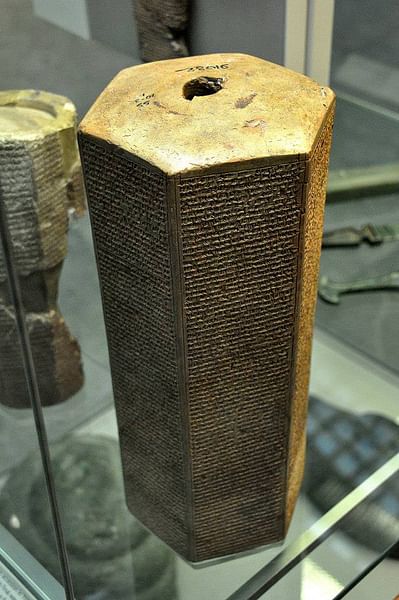
Lachish was taken and the population slaughtered. Those who were spared were deported to regions in Assyria. While the siege was underway, the envoys outside the gates of Jerusalem were in negotiations with Hezekiah's representatives. Referring to Egypt as “a splintered reed” which could be of no help to the city, the Assyrian general addressed Hezekiah's men loudly in Hebrew, rather than Aramaic, so that the people lining the city's walls could understand him.
When Hezekiah's representatives asked him to speak in Aramaic so that the people would not panic, the general refused, saying, “The message is for them too. Like you, they will have to eat their own dung and drink their own urine” (Bauer, 386). Hezekiah released the King of Ekron and sent eleven tons of silver and a ton of gold to Sennacherib at Lachish. The Assyrian army withdrew from Jerusalem to fight the Egyptians at Eltekeh. They defeated the Egyptian forces and then marched back to the region of the Levant and put down the rebellions at Ekron, Tyre, and Sidon.
The Siege of Jerusalem
With order now restored and rebellious populations decimated and deported, Sennacherib turned his attention again to Jerusalem. Although Hezekiah had paid him a handsome tribute, Sennacherib was not one to forgive and forget. He marched on the city and, according to his inscriptions, took it by siege:
As to Hezekiah, the Jew, he did not submit to my yoke, I laid siege to his strong cities, walled forts, and countless small villages, and conquered them by means of well-stamped earth-ramps and battering-rams brought near the walls with an attack by foot soldiers, using mines, breeches as well as trenches. I drove out 200,150 people, young and old, male and female, horses, mules, donkeys, camels, big and small cattle beyond counting, and considered them slaves. Himself I made a prisoner in Jerusalem, his royal residence, like a bird in a cage. I surrounded him with earthwork in order to molest those who were his city's gate. Thus I reduced his country, but I still increased the tribute and the presents to me as overlord which I imposed upon him beyond the former tribute, to be delivered annually. Hezekiah himself, did send me, later, to Nineveh, my lordly city, together with 30 talents of gold, 800 talents of silver, precious stones, antimony, large cuts of red stone, couches inlaid with ivory, nimedu-chairs inlaid with ivory, elephant-hides, ebony-wood, boxwood and all kinds of valuable treasures, his own daughters and concubines.
According to the biblical record of the event, however, the siege was lifted through divine intervention. The Book of II Kings 18-19, the Book of II Chronicles 32, and the Book of Isaiah 37 all claim that Sennacherib laid siege to Jerusalem, but the prophet Isaiah told Hezekiah he had nothing to fear because God would defend the city.
Therefore this is what the Lord says concerning the king of Assyria:
“He will not enter this city
or shoot an arrow here.
He will not come before it with shield
or build a siege ramp against it.
By the way that he came he will return;
he will not enter this city,
declares the Lord.
I will defend this city and save it,
for my sake and for the sake of David my servant.”That night the angel of the Lord went out and put to death a hundred and eighty-five thousand in the Assyrian camp. When the people got up the next morning—there were all the dead bodies! So Sennacherib king of Assyria broke camp and withdrew. He returned to Nineveh and stayed there. (II Kings 19: 31-36)
It is this event, which inspired Lord Byron's 1815 poem, The Destruction of Sennacherib, which made the king's name a household word because schoolchildren would be required to memorize and recite it regularly. By dint of repetition, even those not acquainted with the story in II Kings came to understand that the Assyrian king was defeated by the god of the Hebrews.
Long before Byron wrote his poem, however, Assyrian chroniclers had written on Sennacherib's military campaigns and, contrary to the king's inscription, not one of them mentions him taking Jerusalem and neither does the Bible. While the Bible does record the 46 cities of Judah that fell to the Assyrians (as recorded by Sennacherib), it maintains that Jerusalem was not one of them. Further, although Sennacherib's palace at Nineveh was decorated with reliefs depicting his campaigns and victories including many detailing the siege of Lachish, Jerusalem never appears among them.
Scholars have cited Herodotus' account of the Assyrian's misfortune in battle against Egypt at the city of Pelusium in regards to their siege of Jerusalem. Herodotus writes that the Egyptian leader Sethos prayed to his god for help in defeating the massive Assyrian force, and the god sent into the Assyrian camp “a swarm of field mice [who] gnawed through their quivers and their bows, and the handles of their shields as well, so that the next day, weaponless, all they could do was flee, and their losses were heavy” (II.141).
It is thought that both stories refer to a plague that struck the Assyrian camp and devastated the army on two separate occasions. Whatever happened outside of Jerusalem, whether God's intervention, a plague, or God's intervention in the form of the plague, the city remained intact and Sennacherib returned to Nineveh.
Building Projects & the Invasion of Elam
Back in Nineveh, he devoted himself to further building projects. He had already commissioned the renovation of the city early on and now took on a personal role in overseeing the construction of parks, gardens, and orchards. He was especially fond of flowers and plants and imported specimens from throughout the empire for his public gardens. He paid particular attention to his palace which he called “the Palace without Rival”, the same phrase his father had used to describe the palace at Dur-Sharrukin. Scholar Christopher Scarre writes:
Sennacherib's palace had all the usual accoutrements of a major Assyrian residence: colossal guardian figures and impressively carved stone reliefs (over 2,000 sculptured slabs in 71 rooms). Its gardens, too, were exceptional. Recent research by British Assyriologist Stephanie Dalley has suggested that these were the famous Hanging Gardens, one of the Seven Wonders of the Ancient World. Later writers placed the Hanging Gardens at Babylon, but extensive research has failed to find any trace of them. Sennacherib's proud account of the palace gardens he created at Nineveh fits that of the Hanging Gardens in several significant details. (231)
While he was busying himself with renovation and construction projects in Nineveh, however, trouble was erupting in the south. After he had taken Babylon, Sennacherib placed a trusted official named Bel-ibni on the throne to rule for him. Bel-ibni had been raised alongside Sennacherib in the Assyrian court and was thought to be trustworthy.
It turned out that, however loyal Bel-ibni may have been, he was an incompetent ruler who allowed the southern regions to do whatever they pleased. Merodach-Baladan had returned from hiding and was instigating unrest throughout the region. Sennacherib marched south again to put down the revolts. He sent Bel-ibni back to Nineveh and appointed his own son and chosen heir, Ashur-nadin-shumi, to rule Babylon.
He then went in pursuit of Merodach-Baladan, equipping a vast army to find and kill the rebel leader but, when they finally located him, he had died of natural causes. Sennacherib returned to Nineveh but was soon called to campaign again. The Elamites had kidnapped Ashur-nadin-shumi in c. 695 BCE and claimed Babylon as their own. Sennacherib defeated the Babylonians, re-took the city, and executed the rebels, but there was no word on the fate of his son and no ransom note had been delivered.
This action “produced a full-blown war between Assyria, Babylon, and Elam. Fighting went on for four years” (Bauer, 388). Sennacherib mounted an enormous expedition to invade Elam that included Phoenician ships and the whole might of the Assyrian army. The Elamite king gathered his forces and marched to meet the Assyrians by the banks of the Tigris River. Sennacherib's inscriptions describe the opening battle:
With the dust of their feet covering the wide heavens like a mighty storm, they drew up in battle array before me on the bank of the Tigris. They blocked my passage and offered battle. I put on my coat of mail. My helmet, emblem of victory, I placed upon my head. My great battle chariot which brings low the foe, I hurriedly mounted in the anger of my heart. The mighty bow which Assur had given me I seized in my hands; the javelin, piercing to the life, I grasped. I stopped their advance, succeeding in surrounding them. I decimated the enemy host with arrow and spear. All of their bodies I bored through. I cut their throats like lambs, cut off their precious lives as one cuts string. Like the many waters of a storm I made the contents of their gullets and entrails run down upon the wide earth. My prancing steeds, harnessed for my riding, plunged into the steams of their blood as into a river. The wheels of my war chariot, which brings low the wicked and the evil, were bespattered with filth and blood. With the bodies of their warriors I filled the plain, like grass. Their testicles I cut off and tore their privates like the seeds of cucumbers in June. Then they fled from me. They held back their urine but let their dung go into their chariots. 150,000 of their warriors I cut down with the sword.
While the battle was successful, the war was lost and Sennacherib returned to Nineveh. No inscriptions record the fate of his son, but he is thought to have been executed c. 694 BCE. Babylon and the southern regions remained under Elamite control. Sennacherib went back to his building projects and seemed to have decided to leave Babylon alone.
Sack of Babylon & Death of Sennacherib
When the Elamite king died the following year, Sennacherib mobilized his forces and suddenly struck at Babylon. The city fell and he sent the pretender to the throne back to Nineveh in chains. He had spent more time during his reign dealing with Babylon and the Elamites, and expended more men and resources on subduing the city, than on any other campaign, and so he ordered the city to be razed to the ground. His inscriptions describe the destruction:
I destroyed, I devastated, I burned with fire. The wall and outer-wall, temples and gods, temple-towers of brick and earth, as many as there were, I razed and dumped them into the Arahtu canal. Through the midst of the city I dug canals, I flooded its site with water…That in days to come, the site of that city, and its temples and gods, might not be remembered, I completely blotted it out with floods of water and made it like a meadow. I removed the dust of Babylon for presents to be sent to the most distant peoples.
Babylon was destroyed and the statue of their god, Marduk, was carried back to Nineveh. Sennacherib no longer had to worry about who was ruling in Babylon or what trouble they were causing; the city no longer existed. Sennacherib may have thought that now Babylon would cause him no further problems, but in this, he was mistaken. As in the reign of Tukulti-Ninurta I, the people were outraged at Sennacherib's destruction of the great city and, further, by his sacrilege in plundering the temples and taking the statue of Marduk as a prize. Bauer comments:
Turning Babylon into a lake – covering the civilized land with water, returning the city of Marduk to the primordial chaos – was an insult to the god. Sennacherib compounded this by ordering the statue of Marduk hauled back to Assyria. (389)
The Assyrians and Babylonians revered many of the same gods – even though they often had different names – and this insult to Marduk, the god who had brought order out of chaos, was intolerable and led to the king's assassination.
The biblical Book of II Kings 19:37 gives an account of Sennacherib's death:
One day, while [Sennacherib] was worshiping in the temple of his god Nisrok, his sons Adrammelek and Sharezer killed him with the sword, and they escaped to the land of Ararat. And Esarhaddon his son succeeded him as king.
Assyrian inscriptions also maintain that he was killed by his sons but differ on whether he was stabbed or crushed to death. Scholar Stephen Bertman writes:
Sennacherib was stabbed to death by an assassin (possibly one of his sons) or, according to another account, was crushed to death by the monumental weight of a winged bull that he just happened to be standing beneath. (102)
Whichever way he died, it is thought that he was killed because of his treatment of Babylon although his choice of an heir may also have played a part in his death. It is known that Tukulti-Ninurta I's assassination, also by his sons, was a direct result of his sack of Babylon, so there is the possibility that later scribes conflated the motive behind Sennacherib's assassination with that of Tukulti-Ninurta I, but it is just as possible that the king was killed because he had passed over the sons of his queen for succession and chosen the youngest, Esarhaddon, son of Zakutu (l.c. 728 - c. 668 BCE), one of his secondary wives.
After the kidnapping of Ashur-nadin-shumi, Sennacherib had needed to choose another heir and, in 683 BCE, chose Esarhaddon who was not only the youngest but was not a son of Sennacherib's queen, Tashmetu-sharrat (d. c. 684/681 BCE). The older brothers certainly could have been motivated to kill their father for this snub in order to take the throne for themselves but would have needed a legitimate reason for doing so; the destruction of Babylon would have provided them with justification.
After Sennacherib's assassination, Esarhaddon took the throne and defeated his brothers' factions in a six-week civil war. He then had his brothers' families and associates executed. Once his rule was secure he issued new decrees and proclamations; among the first of these was that Babylon should be restored.
